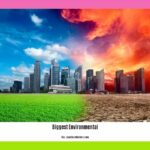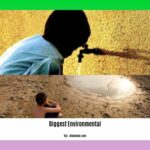Our planet is facing an unprecedented environmental crisis, with a multitude of interconnected challenges threatening the delicate balance of ecosystems and the very survival of countless species. From the looming threat of global warming to the alarming loss of biodiversity, these issues demand our immediate attention and concerted action. In this article, we delve into the 10 biggest environmental problems of our time, exploring their causes, consequences, and potential solutions.
Global Warming: A Planet on the Brink

The Earth’s climate is undergoing a significant transformation, characterized by a gradual increase in average surface temperature. This phenomenon, known as global warming, poses a formidable challenge to humanity and the planet’s ecosystems. The primary driving force behind global warming is human activity, particularly the relentless burning of fossil fuels. The release of greenhouse gases, such as carbon dioxide and methane, traps heat in the atmosphere, leading to a rise in global temperatures.
The consequences of global warming are already evident and are projected to intensify in the future. Rising sea levels threaten coastal communities and low-lying island nations. Extreme weather events, such as heat waves, droughts, floods, and wildfires, are becoming more frequent and intense, wreaking havoc on human settlements and natural landscapes. Ecosystems worldwide are experiencing disruptions, with species facing extinction and delicate habitats facing irreversible damage.
The escalating threat of global warming demands a collective response from individuals, communities, nations, and the international community. A crucial step is transitioning away from fossil fuels and embracing renewable energy sources, such as solar, wind, and geothermal power. Implementing energy efficiency measures and adopting sustainable practices in transportation, agriculture, and industry are essential components of the solution.
Protecting and restoring natural ecosystems is another critical aspect of addressing global warming. Forests, wetlands, and other natural areas play a vital role in absorbing carbon dioxide from the atmosphere. Preserving these ecosystems and promoting reforestation efforts can significantly reduce greenhouse gas emissions.
The challenge of global warming is immense, but it is not insurmountable. By combining scientific knowledge, technological innovation, and a shared commitment to sustainability, we can mitigate the effects of global warming and safeguard the planet for future generations.
Poor Governance: A Hindrance to Sustainable Development
Sustainable development, defined as meeting the needs of the present without compromising the ability of future generations to meet their own needs, is a comprehensive concept that encompasses economic, social, and environmental dimensions. Effective governance is an essential pillar of sustainable development, providing the framework for environmental policies, ensuring the enforcement of regulations, and fostering a culture of environmental stewardship. However, when governance is weak or corrupt, environmental challenges often go unaddressed or are exacerbated. This section explores the detrimental effects of poor governance on sustainable development, highlighting the pervasive issue of corruption, the detrimental effects of weak institutions, and the consequences of a lack of accountability.
Corruption: A Pervasive Obstacle to Environmental Protection
Corruption, the abuse of entrusted power for private gain, poses a significant threat to sustainable development. In the context of environmental protection, corruption erodes the integrity of environmental decision-making and undermines the effectiveness of environmental regulations. Corrupt practices can lead to the following detrimental outcomes:
- Expediting Environmentally Damaging Projects: Corrupt officials may accept bribes to expedite the approval of environmentally damaging projects, bypassing environmental impact assessments and overlooking potential risks to ecosystems and human health.
- Weakening Enforcement of Environmental Laws: Corrupt officials may turn a blind eye to environmental violations, allowing industries and individuals to pollute with impunity. This undermines the effectiveness of environmental regulations and encourages continued environmental degradation.
- Diverting Resources from Sustainable Development Initiatives: Funds earmarked for sustainable development projects may be siphoned off through corrupt practices, depriving these initiatives of essential resources and hindering progress towards environmental goals.
The pervasive nature of corruption in environmental governance poses a major challenge to achieving sustainable development. Without robust anti-corruption measures in place, environmental protection efforts will continue to be undermined, and the environment will continue to suffer.
Weak Institutions: Undermining the Capacity for Environmental Protection
Effective environmental protection requires strong and capable institutions at all levels of government. Weak institutions, characterized by inadequate resources, limited capacity, and a lack of expertise, are ill-equipped to address complex environmental challenges. This can lead to several negative consequences:
- Inadequate Oversight of Environmental Impact Assessments: Weak institutions may lack the capacity to conduct thorough and comprehensive environmental impact assessments, potentially overlooking significant environmental risks associated with proposed projects.
- Lax Enforcement of Environmental Regulations: Without adequate enforcement mechanisms, environmental regulations may be disregarded, allowing industries and individuals to flout environmental laws with impunity. This can lead to widespread environmental degradation.
- Failure to Invest in Sustainable Infrastructure: Weak institutions may lack the foresight and resources to invest in sustainable infrastructure, such as renewable energy sources, waste management systems, and public transportation networks. This can hinder the transition towards a more sustainable society.
Strengthening environmental institutions is crucial for effective environmental protection and sustainable development. By investing in the capacity and resources of these institutions, governments can ensure that environmental concerns are adequately addressed and that sustainable development goals are pursued with rigor and determination.
Lack of Accountability: Eroding Public Trust and Environmental Stewardship
Accountability, the requirement for individuals and organizations to be held responsible for their actions, is a fundamental principle of good governance. In the context of environmental protection, accountability ensures that public officials and private entities are held responsible for their environmental decisions and actions. When accountability is lacking, the following consequences can arise:
- Culture of Impunity: A lack of accountability can foster a culture of impunity, where environmental violations go unpunished and individuals and organizations feel emboldened to disregard environmental regulations.
- Sidelining Environmental Concerns: Without clear lines of accountability, environmental concerns may be easily sidelined or ignored in favor of short-term economic or political interests.
- Erosion of Public Trust: A lack of accountability can erode public trust in government and environmental institutions, making it more difficult to mobilize public support for environmental protection efforts.
Strengthening accountability mechanisms is essential for fostering a culture of environmental stewardship and ensuring that environmental concerns are taken seriously. By holding individuals and organizations accountable for their actions, governments can send a clear message that environmental protection is a priority and that those who harm the environment will be held responsible.
Conclusion: Addressing Governance Challenges for a Sustainable Future
Poor governance, characterized by corruption, weak institutions, and a lack of accountability, poses a significant barrier to sustainable development. By addressing these governance challenges, countries can create an environment conducive to environmental protection and sustainable practices. Strengthening institutions, promoting transparency and accountability, and fostering public participation are essential steps towards achieving a sustainable future for all.
Food Waste: A Squandered Resource
In a world where millions face food insecurity, the widespread discarding of edible food is a paradox of immense proportions. Food waste, the discarding of edible food, is a global problem with far-reaching consequences. This section delves into the magnitude of food waste, its environmental implications, and the economic and social repercussions it entails.
The Staggering Scale of Food Waste
The sheer scale of food waste is staggering. According to the Food and Agriculture Organization of the United Nations (FAO), an estimated one-third of all food produced globally, approximately 1.3 billion tonnes, is lost or wasted each year. This staggering amount represents a loss of valuable resources, including water, land, energy, and labor.
The problem of food waste is pervasive, affecting all stages of the food supply chain, from production and harvesting to processing, distribution, and consumption. In developing countries, food waste is often attributed to inefficiencies in harvesting, storage, and transportation, while in developed nations, consumer behavior plays a significant role.
Environmental Consequences: A Burden on the Planet
Food waste is not merely a loss of edible food; it is also a major contributor to greenhouse gas emissions. When food decomposes in landfills, it releases methane, a potent greenhouse gas 25 times more effective than carbon dioxide at trapping heat in the atmosphere.
Moreover, food waste puts a strain on waste management systems, increasing the demand for landfills and exacerbating environmental pollution. The disposal of food waste generates leachate, a liquid containing harmful contaminants that can contaminate groundwater and waterways.
Economic and Social Repercussions: A Waste of Resources
The economic and social repercussions of food waste are equally concerning. The lost value of food waste is estimated at trillions of dollars annually, representing a significant economic drain. This loss of potential revenue could be redirected towards addressing food insecurity and improving nutrition in vulnerable communities.
Furthermore, food waste highlights the disconnect between food production and consumption. While millions face hunger and malnutrition, a significant portion of the food produced is discarded, underscoring the need for more sustainable and equitable food systems.
Addressing Food Waste: A Collective Responsibility
Tackling food waste requires a multi-pronged approach that addresses the issue throughout the food supply chain. Governments, businesses, and individuals all have a role to play in reducing food waste and creating a more sustainable food system.
Governments can implement policies that encourage sustainable food production practices, support food rescue initiatives, and promote consumer education on food waste reduction. Businesses can adopt strategies to improve food storage, distribution, and packaging, while also educating consumers on proper food handling and storage.
Individuals can take responsibility by planning meals, purchasing only what they need, storing food properly, and composting food scraps. By adopting simple yet effective practices, individuals can significantly reduce their contribution to food waste.
Reducing food waste is not just about saving money and resources; it is also about ensuring a more equitable and sustainable food system for all. By addressing food waste, we can alleviate hunger, reduce our environmental footprint, and create a more resilient food system for future generations.
Deforestation: Losing Our Lungs
Forests, often referred to as the Earth’s lungs, play an indispensable role in maintaining the planet’s delicate ecological balance. They harbor an astounding diversity of life, regulate local and global climate patterns, and provide a myriad of essential resources that support human societies. However, the relentless expansion of human activities, driven by the insatiable demands of agriculture, urbanization, and resource extraction, is leading to the rapid and alarming destruction of these vital ecosystems. This section explores the devastating consequences of deforestation, highlighting its impact on biodiversity, climate regulation, and human well-being.
Biodiversity Loss: A Silent Extinction
Forests are home to an estimated 80% of the world’s terrestrial biodiversity, encompassing a vast array of plant and animal species. Deforestation, by fragmenting and destroying forest habitats, disrupts the intricate web of life that sustains these species. As trees are felled and forests are cleared, countless species face habitat loss, fragmentation, and isolation, increasing their vulnerability to extinction.
The loss of biodiversity is not merely an ecological concern; it also has profound implications for human well-being. Forests provide essential ecosystem services, such as pollination, pest control, and water purification, which are crucial for maintaining human health and agricultural productivity. The decline of biodiversity threatens these services, jeopardizing human food security and overall well-being.
Climate Disruption: An Unbalanced Atmosphere
Forests play a critical role in regulating the Earth’s climate. They act as carbon sinks, absorbing carbon dioxide from the atmosphere and storing it in their biomass. As forests are cleared, this stored carbon is released back into the atmosphere, exacerbating the greenhouse effect and contributing to global warming.
Deforestation also disrupts local and regional climate patterns. Forests influence rainfall patterns, temperature regulation, and humidity levels. Their removal can lead to increased temperatures, altered precipitation patterns, and more extreme weather events, with far-reaching consequences for agriculture, water resources, and human settlements.
Human Impacts: Losing Essential Resources
Forests provide a wealth of essential resources that support human societies. They are a source of timber, food, medicines, and countless other products that underpin human livelihoods. Deforestation not only deprives communities of these resources but also disrupts traditional livelihoods and cultural practices that are deeply intertwined with the forest environment.
The loss of forests also has severe consequences for water security. Forests act as natural sponges, absorbing and storing rainwater, which then slowly releases into streams and rivers. Deforestation disrupts this process, leading to increased water runoff, soil erosion, and water scarcity. This poses a significant threat to human health, agriculture, and economic development.
Addressing Deforestation: A Collective Responsibility
Tackling deforestation requires a collective effort that involves governments, businesses, and individuals. Governments can implement policies that promote sustainable forestry practices, strengthen forest protection measures, and support reforestation initiatives. Businesses can adopt sustainable procurement policies, reduce their reliance on forest products, and invest in forest conservation efforts.
Individuals can make informed choices about the products they consume, supporting companies that prioritize sustainable practices and avoiding products that contribute to deforestation. They can also engage in advocacy efforts, raising awareness about the importance of forests and supporting organizations working to protect them.
Protecting our dwindling forests is not just an environmental imperative; it is an investment in our collective future. By conserving these vital ecosystems, we safeguard biodiversity, ensure climate stability, and protect the resources that underpin human well-being. A future without forests would be a future of climate instability, resource scarcity, and diminished human prosperity. The time to act is now, to ensure that our forests, the Earth’s lungs, continue to breathe life into our planet.
Biodiversity Loss: A Web of Life Under Threat
The Earth is home to an astounding diversity of life, from tiny microbes to towering trees, from delicate insects to majestic whales. This vast array of species, known as biodiversity, is not merely a collection of organisms; it is a complex web of life that underpins the health of our planet. Biodiversity provides us with essential services, such as clean air and water, food pollination, and protection from natural disasters. It also contributes to our physical and mental well-being, providing opportunities for recreation, relaxation, and inspiration.
However, biodiversity is facing a multitude of threats, driving species extinction at an unprecedented rate. The primary drivers of biodiversity loss include:
Habitat Loss: As human populations expand and their activities intensify, natural habitats are being destroyed or fragmented at an alarming rate. Forests are cleared for agriculture, urbanization, and resource extraction, while wetlands are drained for development. This loss of habitat disrupts the intricate web of life, leaving many species without the resources they need to survive.
Pollution: The release of harmful substances into the environment, such as chemicals, pesticides, and fertilizers, is having a devastating impact on biodiversity. These pollutants contaminate ecosystems, disrupt food chains, and directly harm many species.
Climate Change: The Earth’s climate is changing at an unprecedented rate due to human activities, primarily the burning of fossil fuels. This is leading to changes in temperature, precipitation patterns, and sea levels. These changes are disrupting the delicate balance of ecosystems and putting many species at risk.
The consequences of biodiversity loss are far-reaching and profound. The loss of species can lead to ecosystem collapse, reduced resilience to environmental stressors, and disruptions to natural processes that underpin human well-being. Moreover, the extinction of species has a significant impact on cultural and spiritual values, depriving communities of their traditions and connections to the natural world.
Addressing biodiversity loss requires a multi-pronged approach that encompasses conservation, sustainable development, and public engagement. Governments can implement policies that protect threatened species, conserve critical habitats, and promote sustainable practices. Businesses can adopt policies that reduce their environmental impact, source products sustainably, and invest in conservation efforts. Individuals can make informed choices about their consumption habits, support sustainable practices, and advocate for biodiversity conservation.
Protecting biodiversity is not just an environmental imperative; it is an investment in our future. By safeguarding the rich tapestry of life on Earth, we ensure that future generations can inherit a planet that is healthy, resilient, and full of life.
Fast Fashion: A Culture of Excess and Waste

The advent of fast fashion has transformed the apparel industry, introducing a relentless cycle of rapidly changing trends and low-cost clothing. This model, driven by consumer demand for constant novelty and affordability, has undoubtedly democratized fashion, making it accessible to a wider audience. However, this convenience comes at a significant environmental cost, as the fast fashion industry is characterized by excessive resource consumption, pollution, and waste generation.
Environmental Impact: A Heavy Footprint
The production of fast fashion garments requires vast amounts of natural resources. Cotton, the dominant fiber used in fast fashion, is a water-intensive crop, requiring an estimated 2,700 liters of water to produce just one T-shirt. Moreover, the cultivation of cotton often involves the use of harmful pesticides and fertilizers, contributing to soil degradation and water pollution.
The dyeing and finishing processes involved in fast fashion production also generate significant environmental pollution. Textile dyes, often containing hazardous chemicals, contaminate waterways and pose health risks to workers and local communities. Additionally, the production of synthetic fibers, commonly used in fast fashion garments, releases harmful microplastics into the environment, disrupting ecosystems and posing risks to marine life.
Waste Generation: A Disposable Culture
The relentless cycle of trends in fast fashion leads to a culture of disposability. Consumers are constantly enticed to purchase new garments, often at the expense of quality and durability. This results in a staggering amount of textile waste, with an estimated 92 million tons of textile waste generated annually.
Landfills, the primary destination for textile waste, release harmful methane emissions as the garments decompose. Moreover, the synthetic fibers used in fast fashion garments can persist in landfills for centuries, posing a long-term environmental threat.
Addressing the Challenges: A Sustainable Future for Fashion
Transitioning away from the unsustainable practices of fast fashion requires a collective effort from industry leaders, policymakers, and consumers. Industry players can adopt sustainable practices, such as using recycled materials, implementing eco-friendly dyeing and finishing processes, and extending the lifespan of garments through design and manufacturing innovations.
Policymakers can introduce regulations and incentives to promote sustainable practices in the fashion industry, such as mandating the use of recycled materials, enforcing stricter environmental standards, and increasing consumer awareness about the environmental impacts of fast fashion.
Consumers can play a crucial role by making informed choices about their purchases, prioritizing quality over quantity, and supporting brands committed to sustainable practices. Embracing secondhand clothing, extending the lifespan of garments through proper care, and advocating for sustainable fashion options can significantly reduce the environmental impact of fast fashion.
Transforming the fashion industry towards sustainability is not merely an environmental imperative; it is an opportunity to redefine the relationship between fashion and consumption. By moving away from a culture of disposability and embracing sustainable practices, we can create a fashion industry that is environmentally responsible, ethically sound, and economically viable, ensuring a more sustainable future for all.
Illegal Fishing: Plundering the Seas
The oceans, covering over 70% of the Earth’s surface, are teeming with life, forming the foundation of marine ecosystems that support an abundance of marine species and provide essential services to humanity. However, the relentless pursuit of marine resources has led to the emergence of a significant threat to the health of our oceans: illegal fishing.
Illegal, unreported, and unregulated (IUU) fishing, also known as pirate fishing, involves the unauthorized harvesting of fish or other marine resources. Driven by financial gain and a disregard for regulations, IUU fishing is a global scourge, plundering the seas and jeopardizing the sustainability of marine ecosystems.
The Devastating Impacts of Illegal Fishing
The consequences of IUU fishing are far-reaching and severe, impacting marine ecosystems, economies, and food security. The rampant exploitation of fish stocks through illegal fishing practices leads to:
- Depletion of Fish Stocks: IUU fishing undermines the natural ability of fish populations to replenish themselves, leading to overfishing and stock depletion. This threatens the survival of countless marine species and jeopardizes the livelihoods of millions of people who depend on fishing for their sustenance.
- Disruption of Marine Food Chains: The indiscriminate harvesting of fish through illegal practices disrupts the delicate balance of marine food chains. The removal of key species can have cascading effects throughout the ecosystem, impacting the abundance and distribution of other organisms.
- Damage to Sensitive Habitats: Illegal fishing often involves the use of destructive fishing gear and practices, such as bottom trawling and dynamite fishing, which can cause irreparable damage to sensitive marine habitats, such as coral reefs and seagrass meadows. These habitats are vital for the survival of many marine species and play a crucial role in maintaining the health of marine ecosystems.
Addressing the Challenge: A Global Effort
Tackling IUU fishing requires a concerted global effort that involves governments, international organizations, the fishing industry, and consumers. Governments must strengthen their enforcement of fishing regulations, improve monitoring and surveillance systems, and collaborate with neighboring countries to combat cross-border IUU fishing.
International organizations, such as the Food and Agriculture Organization of the United Nations (FAO) and the Regional Fisheries Management Organizations (RFMOs), play a critical role in developing and implementing global standards for sustainable fishing practices and enforcing compliance with international agreements.
The fishing industry must take responsibility for its actions and adopt sustainable fishing practices that respect the health of marine ecosystems. This includes implementing responsible fishing gear and techniques, adhering to quotas and regulations, and ensuring traceability of seafood products.
Consumers can also contribute to combating IUU fishing by making informed choices about the seafood they purchase. Supporting sustainable fisheries, choosing seafood with eco-labels, and avoiding seafood from known IUU fishing hotspots are effective ways to reduce demand for illegally caught fish.
Ultimately, protecting our oceans from IUU fishing requires a shift in mindset, moving away from a culture of exploitation and embracing a sustainable approach to managing marine resources. By working together, we can safeguard the health of our oceans, ensure the sustainability of marine ecosystems, and protect the livelihoods of those who depend on the sea.
Illegal Wildlife Trade: A Threat to Biodiversity
The illegal wildlife trade, the illicit trafficking of wild animals and their products, is a significant threat to biodiversity and the delicate balance of ecosystems worldwide. This pernicious activity involves the capture, transportation, and sale of wild animals and their derivatives, such as ivory, horns, and exotic pets, often for exorbitant profit. The illegal wildlife trade has far-reaching consequences, driving species to the brink of extinction, fueling organized crime, and disrupting the intricate web of life that sustains our planet.
Accelerated Extinction: A Looming Crisis
The illegal wildlife trade is a major driver of biodiversity loss, pushing countless species towards extinction. The insatiable demand for wildlife products, driven by vanity, cultural beliefs, and medicinal misconceptions, has led to the relentless poaching of elephants, rhinos, tigers, and countless other species. The illegal trade decimates populations, disrupts reproductive cycles, and fragments habitats, leaving many species on the precipice of extinction.
A Lucrative Underworld: Fueling Organized Crime
The illegal wildlife trade is a lucrative and highly organized criminal enterprise, often intertwined with other illicit activities such as arms trafficking and drug smuggling. Criminal networks exploit sophisticated transportation routes, utilize advanced communication technologies, and employ corrupt officials to facilitate the illegal movement of wildlife products across borders. These illicit activities generate vast sums of money, fueling organized crime and undermining law enforcement efforts worldwide.
Ecosystem Disruption: A Ripple Effect
The illegal wildlife trade extends beyond the immediate harm to individual species, disrupting the intricate web of life that sustains ecosystems. The removal of key predators, such as tigers and lions, can have cascading effects on prey populations and disrupt the delicate balance of food chains. The loss of pollinators, such as orchids and butterflies, can impact plant reproduction and disrupt agricultural productivity. The illegal trade also introduces invasive species, further destabilizing ecosystems and posing threats to native biodiversity.
Combating the Crisis: A Collective Responsibility
Tackling the illegal wildlife trade requires a multi-pronged approach that encompasses enforcement, demand reduction, and community engagement. Governments must strengthen their enforcement mechanisms, increase penalties for wildlife crimes, and enhance international cooperation to disrupt trafficking networks.
Public awareness campaigns are crucial to reduce consumer demand for illegal wildlife products, educating the public about the devastating consequences of the trade and promoting alternatives to illegal wildlife products.
Community engagement is essential to address the underlying causes of the illegal wildlife trade, providing alternative livelihoods and fostering a sense of stewardship among communities that live alongside wildlife.
Protecting Our Planet’s Heritage: A Moral Imperative
The illegal wildlife trade is not merely an environmental issue; it is a moral imperative. The loss of irreplaceable species and the disruption of ecosystems not only diminishes our planet’s biodiversity but also deprives future generations of experiencing the wonders of the natural world.
By safeguarding wildlife and combating the illegal wildlife trade, we protect our planet’s heritage, ensure the resilience of ecosystems, and uphold our shared responsibility to future generations. The time to act is now, to safeguard the intricate tapestry of life on Earth and ensure a future where wildlife thrives.
Oil and Gas Development: A Legacy of Environmental Pollution
Oil and gas development has been a cornerstone of modern civilization, providing essential energy sources that have fueled industrial growth, transportation, and electricity generation. However, this reliance on fossil fuels has come at a significant environmental cost. The extraction, processing, and transportation of oil and gas release harmful pollutants into the air and water, destroy natural habitats, and contribute to greenhouse gas emissions, exacerbating climate change.
Air Pollution: A Toxic Legacy
Oil and gas operations emit a cocktail of air pollutants, including volatile organic compounds (VOCs), nitrogen oxides (NOx), sulfur dioxide (SO2), and particulate matter (PM). These pollutants can cause respiratory problems, heart disease, and cancer. The release of methane, a potent greenhouse gas, from oil and gas infrastructure also contributes to climate change.
Water Pollution: Contaminating Precious Resources
Oil and gas activities can contaminate freshwater and marine ecosystems through spills, leaks, and runoff. These contaminants can harm aquatic life, disrupt ecosystems, and pose health risks to communities that rely on these water sources for drinking, fishing, and recreation.
Habitat Destruction: Fragmenting Natural Landscapes
The construction of pipelines, roads, and drilling sites for oil and gas extraction fragments and destroys natural habitats, disrupting the delicate balance of ecosystems and displacing wildlife. This can lead to species decline, ecosystem collapse, and a loss of biodiversity.
Greenhouse Gas Emissions: Fueling Climate Change
The burning of oil and gas releases carbon dioxide (CO2), a primary greenhouse gas, into the atmosphere. This contributes to global warming, leading to rising sea levels, extreme weather events, and disruptions to ecosystems and human societies.
Addressing the Environmental Impacts: A Transition to Sustainable Energy
Mitigating the environmental impacts of oil and gas development requires a multifaceted approach that includes:
- Strengthening Environmental Regulations: Implementing stricter regulations and enforcement mechanisms can reduce pollution emissions, minimize habitat destruction, and prevent environmental accidents.
- Investing in Cleaner Technologies: Developing and adopting cleaner technologies, such as carbon capture and storage (CCS), can reduce the environmental footprint of oil and gas operations.
- Promoting Renewable Energy Sources: Transitioning towards renewable energy sources, such as solar, wind, and geothermal power, can reduce reliance on fossil fuels and mitigate climate change.
- Enhancing Public Awareness: Educating the public about the environmental impacts of oil and gas development can foster informed decision-making and encourage support for sustainable energy alternatives.
A Sustainable Future: Beyond Fossil Fuels
While oil and gas have played a significant role in human development, their environmental impacts necessitate a shift towards a more sustainable energy future. By embracing cleaner technologies, promoting renewable energy sources, and adopting sustainable practices, we can reduce our reliance on fossil fuels, protect the environment, and ensure a more sustainable future for generations to come.
The Urgency of Collective Action
The interconnectedness of these environmental problems underscores the urgency of collective action. Addressing these challenges requires a multifaceted approach that involves individuals, businesses, governments, and international organizations.
Individual Actions: Small Steps, Big Impact
Individuals can play a significant role in environmental protection by adopting sustainable practices in their daily lives. These include:
- Reducing energy consumption: Conserving energy at home by switching to energy-efficient appliances, using natural light whenever possible, and unplugging electronics when not in use can significantly reduce energy consumption and greenhouse gas emissions.
- Conserving water: Simple actions such as taking shorter showers, fixing leaky faucets, and using water-efficient appliances can help conserve water resources, especially in areas facing water scarcity.
- Adopting sustainable food choices: Choosing locally grown, organic produce, reducing meat consumption, and composting food scraps can minimize the environmental impact of food production and waste.
- Reducing waste and recycling: Embracing the principles of reduce, reuse, and recycle can significantly reduce the amount of waste generated and conserve resources.
- Supporting sustainable businesses: Choosing products from companies committed to environmental sustainability and ethical practices can drive positive change within the business sector.
Businesses: Leading by Example
Businesses can play a pivotal role in environmental protection by integrating sustainability into their operations and practices. This includes:
- Adopting sustainable practices: Implementing energy-efficient technologies, reducing waste generation, and using eco-friendly materials and processes can minimize the environmental footprint of businesses.
- Investing in renewable energy: Transitioning to renewable energy sources, such as solar, wind, or geothermal power, can reduce reliance on fossil fuels and mitigate climate change impacts.
- Embracing sustainable supply chains: Collaborating with suppliers who prioritize sustainable practices can ensure that the environmental impacts of products and services are addressed throughout the supply chain.
- Educating employees and customers: Raising awareness among employees and customers about environmental issues and encouraging sustainable practices can foster a culture of environmental stewardship.
- Advocating for sustainable policies: Engaging with policymakers and supporting policies that promote environmental protection can create a supportive environment for sustainable business practices.
Governments: Setting the Framework for Change
Governments can play a crucial role in enabling and enforcing environmental protection measures. This includes:
- Establishing and enforcing environmental regulations: Implementing strong environmental regulations and ensuring their effective enforcement can deter harmful practices and protect the environment.
- Investing in environmental infrastructure: Investing in renewable energy infrastructure, waste management systems, and public transportation can promote sustainability and reduce environmental impacts.
- Providing incentives for sustainable practices: Offering tax breaks, subsidies, or other incentives can encourage businesses and individuals to adopt sustainable practices.
- Supporting research and innovation: Investing in research and development of clean technologies and sustainable practices can accelerate progress towards environmental solutions.
- Engaging in international cooperation: Collaborating with other nations on environmental issues, such as climate change and biodiversity conservation, can address transboundary challenges and foster global solutions.
International Organizations: Fostering Global Collaboration
International organizations can play a crucial role in coordinating global efforts to address environmental challenges. This includes:
- Setting international environmental standards: Establishing and enforcing international environmental standards can harmonize environmental regulations across countries and ensure a level playing field for businesses.
- Facilitating knowledge sharing and technology transfer: Promoting the exchange of environmental expertise and technologies among nations can accelerate the adoption of sustainable practices worldwide.
- Providing financial assistance and support: Offering financial assistance and technical support to developing countries can help them implement environmental protection measures and adapt to climate change impacts.
- Mediating environmental disputes: Facilitating dialogue and mediation between nations on environmental issues can help resolve conflicts and promote cooperation.
- Monitoring and reporting on environmental progress: Regularly monitoring and reporting on environmental trends and progress can provide a basis for informed decision-making and track the effectiveness of environmental policies.
Collective Responsibility: A Sustainable Future
The interconnectedness of environmental challenges demands a collective response that transcends individual actions, business practices, and national boundaries. Addressing these challenges requires a concerted effort from all stakeholders, including individuals, businesses, governments, and international organizations. By working together, we can create a more sustainable future for all.
Explore the remarkable advantages of air transportation and why it’s a game-changer in the world of travel and logistics. Find out more here!
Discover the 10 best ways to reduce air pollution and contribute to a cleaner environment for all. Dive into these effective solutions here!
Uncover the root causes of noise pollution that impact our daily lives. Learn about the top 10 culprits behind this issue right here!
Conclusion: A Call for Environmental Stewardship
The environmental crisis we face is not insurmountable. With concerted action, innovation, and a shared commitment to environmental stewardship, we can safeguard our planet for future generations. Let us rise to the challenge and protect the Earth, our only home.
- Crypto Quotes’ Red Flags: Avoid Costly Mistakes - June 30, 2025
- Unlock Inspirational Crypto Quotes: Future Predictions - June 30, 2025
- Famous Bitcoin Quotes: A Deep Dive into Crypto’s History - June 30, 2025
















